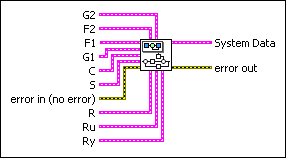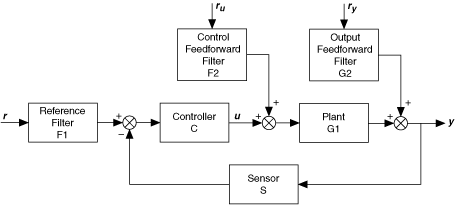Owning Palette: Optimal Design VIs
Installed With: Control Design and Simulation Module
Constructs a dynamic system model you can wire to the System Data input of the SIM Optimal Design VI. This dynamic system model consists of a controller, a plant, a sensor, and three filters.

 Place on the block diagram Place on the block diagram |  Find on the Functions palette Find on the Functions palette |
 | G2 specifies information about the output feedforward filter. | ||||||||||||||
 | F2 specifies information about the control feedforward filter. | ||||||||||||||
 | F1 specifies information about the reference filter. | ||||||||||||||
 | G1 specifies information about the plant. | ||||||||||||||
 | C specifies information about the controller. | ||||||||||||||
 | S specifies information about the sensor. | ||||||||||||||
 | error in describes error conditions that occur before this VI or function runs.
The default is no error. If an error occurred before this VI or function runs, the VI or function passes the error in value to error out. This VI or function runs normally only if no error occurred before this VI or function runs. If an error occurs while this VI or function runs, it runs normally and sets its own error status in error out. Use the Simple Error Handler or General Error Handler VIs to display the description of the error code.
Use exception control to treat what is normally an error as no error or to treat a warning as an error.
Use error in and error out to check errors and to specify execution order by wiring error out from one node to error in of the next node.
| ||||||||||||||
 | R specifies information about the reference input signal to the controller C.
Refer to the Details section for the information about how this signal applies to the dynamic system model.
| ||||||||||||||
 | Ru specifies information about the input signal to the plant G1. This input signal passes through the control feedforward filter F2.
Refer to the Details section for the information about how this signal applies to the dynamic system model.
| ||||||||||||||
 | Ry specifies information about the input signal that this VI combines with output from the plant G1. This input signal passes through the output feedforward filter G2.
Refer to the Details section for the information about how this signal applies to the dynamic system model.
| ||||||||||||||
 | System Data returns information about the dynamic system that this VI constructs. You can wire this output to the System Data input of the SIM Optimal Design VI. Refer to the Details section for the structure of this dynamic system. | ||||||||||||||
 | error out contains error information. If error in indicates that an error occurred before this VI or function ran, error out contains the same error information. Otherwise, it describes the error status that this VI or function produces.
Right-click the error out front panel indicator and select Explain Error from the shortcut menu for more information about the error.
|
SIM Construct Default System Details
Dynamic System Structure
This VI constructs a dynamic system model with the following structure:

Dynamic System Components
G2, F2, F1, G1, C, and S consist of one or more transfer functions and information about the transfer function(s), such as delays.
By default, C is a parallel proportional integral derivative (PID) controller defined by the following equation:

Defining a Custom Reference Signal
The System Data parameter of this VI contains the Signal Parameters Array parameter, which specifies values for reference signals ru, ry, and r. If you define a custom dynamic system, ru and ry must be the first two elements of the Signal Parameters Array, respectively. You can define custom reference signals starting with the third element.
Examples
Refer to the following VIs for examples of using the SIM Construct Default System VI:
- PID Design for Second Order Continuous System VI: labview\examples\Control and Simulation\Simulation\Optimal Control Design
- PID Design for Second Order Discrete System VI: labview\examples\Control and Simulation\Simulation\Optimal Control Design








